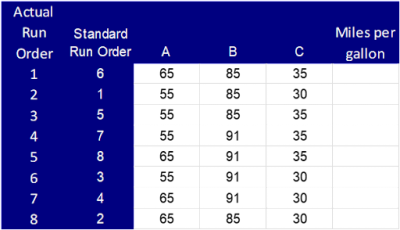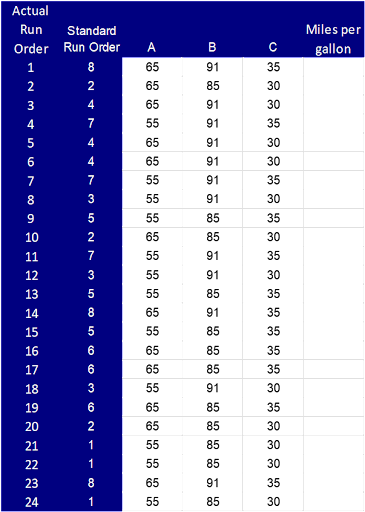
Replication is the non consecutive running of the experimental design multiple times. The purpose is to provide additional information and degrees of freedom to better understand and estimate the variation in the experiment. It is not the same as repetition. Let’s learn a little bit more about this.
Overview: What is replication?
Three important concepts in Design of Experiments (DOE) are randomization, repetition and replication. In DOE you identify potential factors which, if set at different levels, will impact some desired response variable. This allows you to predict the outcome of your response variable based on the optimal settings for your factors and levels.
Dependent upon the number of factors and levels, your DOE will be run as combinations of the factors and levels. The order of those runs should be randomized to block out any unwarranted noise in the experiment. Doing multiple runs of the same combinations will provide more data and a better estimate of the variation.
If you do consecutive runs of a specific combination you call that repetition which does not add any additional understanding of your variation. But, if you run multiple combinations of factors and levels non sequentially, you are now doing replication. Repetition would be equivalent to repeatability in Measurement System Analysis (MSA) while replication would be equivalent to reproducibility.
In summary, repetition and replication are both multiple response measurements taken at the same combination of factor settings. Repeat measurements are taken during the same experimental run or consecutive runs. Replicate measurements are taken during identical but different experimental runs.
An industry example of replication
Here is what a non replicated and replicated design matrix looks like for a full factorial three factor/two level randomized experiment using 3 replicates which a Six Sigma Black Belt wanted to run.

Note, that in most cases, the consecutive replicated runs below are not identical.

Frequently Asked Questions (FAQ) about replication
What is the difference between replication and repetition?
Both are repeated runs of your combination of factors and levels. Repetition does the duplicate runs consecutively while replication does multiple runs but during identical but different experimental runs.
What is the purpose of doing experimental replication?
The addition of replicated runs will provide more information about the variability of the process and will reflect the variation of the setup between runs.
Does replication affect the power of an experiment?
Yes. The more replicated runs you have, the more data you will gather during your experiment. The increased data and understanding of your variation will allow you to increase your power and improve your precision and ability to spot the effect of your factors and levels on your response variable.